TDMQ for CKafka
- Release Notes and Announcements
- Product Introduction
- Technical Principles
- High Availability
- Purchase Guide
- Billing Overview
- Getting Started
- Obtaining Access Permission
- VPC Access
- Step 4. Send/Receive Messages
- Access via Public Domain Name
- Step 5. Send/Receive Messages
- Development Guide
- Operation Guide
- Instance Management
- Topic Management
- Instance Topic
- Elastic Topic
- Consumer Group
- Monitoring and Alarms
- Smart Ops
- Permission Management
- Migration to Cloud
- CKafka Connector
- Task Management
- Creating Data Access Task
- Creating Data Distribution Task
- Simple Data Processing
- Practical Tutorial
- Practical Tutorial of CKafka Client
- Connector Practical Tutorial
- Reporting over HTTP
- Querying Subscription to Database Change Info
- Log Access
- Troubleshooting
- Topic Failures
- Consumer Group Failures
- Client Failures
- API Documentation
- Making API Requests
- DataHub APIs
- ACL APIs
- Topic APIs
- Instance APIs
- Other APIs
- SDK Documentation
- SDK for Java
- SDK for Python
- SDK for Node.js
- SDK for Connector
- Elastic Topic Message Sending and Receiving
- General References
- Connector
- Database Change Subscription
- FAQs
Connecting Schema Registry to CKafka
Last updated: 2024-07-19 14:25:46
We can serialize/deserialize classes by using Avro APIs or the Twitter Bijection class library, but the disadvantage of the two methods is that the Kafka record size will multiply as each record must be embedded with a schema. However, the schema is required for reading the records.
CKafka makes it possible for data to share one schema by registering the content of the schema in Confluent Schema Registry. Kafka producers and consumers can implement serialization/deserialization by identifying the schema content in Confluent Schema Registry.
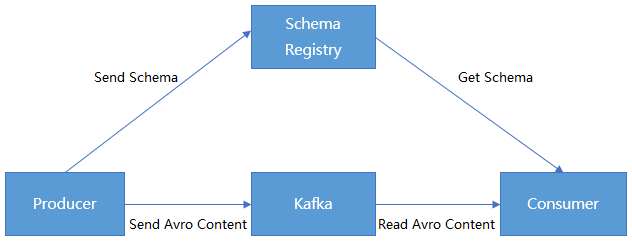
Prerequisites
You have downloaded JDK 8.
You have downloaded Confluent OSS 4.1.1.
You have created an instance as instructed in Creating Instance.
Directions
Step 1. Obtain the instance access address and enable automatic topic creation
1. Log in to the CKafka console.
2. Select Instance List on the left sidebar and click the ID of the target instance to enter its basic information page.
3. On the instance's basic information page, get the instance access address in the Access Mode module.

4. Enable automatic topic creation in the Auto-Create Topic module.
Note:
Automatic topic creation must be enabled as a topic named
schemas will be automatically created when OSS is started.Step 2. Prepare Confluent configurations
1. Modify the server address and other information in the OSS configuration file.
The configuration information of the PLAINTEXT access method is as follows:
kafkastore.bootstrap.servers=PLAINTEXT://xxxxkafkastore.topic=schemasdebug=true
The configuration information of the SASL_PLAINTEXT access method is as follows:
kafkastore.bootstrap.servers=SASL_PLAINTEXT://ckafka-xxxx.ap-xxx.ckafka.tencentcloudmq.com:50004 kafkastore.security.protocol=SASL_PLAINTEXT kafkastore.sasl.mechanism=PLAIN kafkastore.sasl.jaas.config=org.apache.kafka.common.security.plain.PlainLoginModule required username='ckafka-xxxx#xxxx' password='xxxx';kafkastore.topic=schemasdebug=true
Note:
bootstrap.servers: Access the network and copy from the network column of the Access Method section on the instance details page in the CKafka Console.
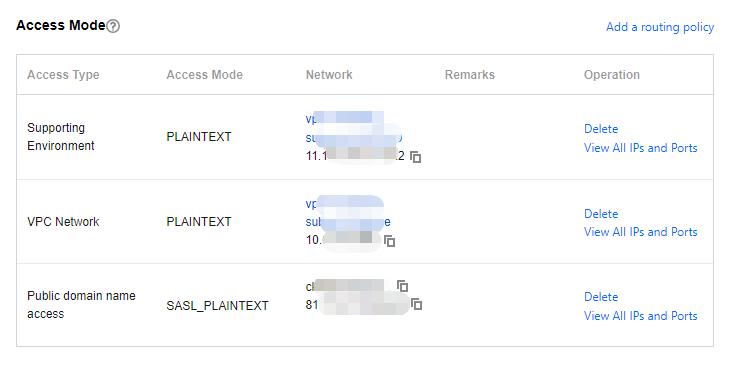
2. Run the following command to start Schema Registry.
bin/schema-registry-start etc/schema-registry/schema-registry.properties
The execution result is as follows:
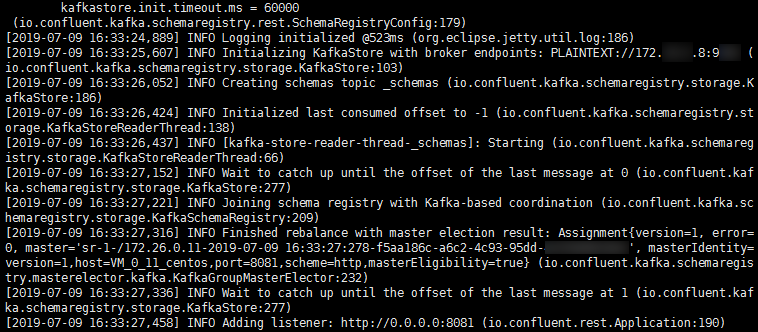
Step 3. Receive/Send messages
Below is the content of the schema file:
{"type": "record","name": "User","fields": [{"name": "id", "type": "int"},{"name": "name", "type": "string"},{"name": "age", "type": "int"}]}
1. Register the schema in the topic named
test.The script below is an example of registering a schema by calling an API with the
curl command in the environment deployed in Schema Registry.curl -X POST -H "Content-Type: application/vnd.schemaregistry.v1+json" \\--data '{"schema": "{\\"type\\": \\"record\\", \\"name\\": \\"User\\", \\"fields\\": [{\\"name\\": \\"id\\", \\"type\\": \\"int\\"}, {\\"name\\": \\"name\\", \\"type\\": \\"string\\"}, {\\"name\\": \\"age\\", \\"type\\": \\"int\\"}]}"}' \\http://127.0.0.1:8081/subjects/test/versions
2. The Kafka producer sends messages.
package schemaTest;import java.util.Properties;import java.util.Random;import org.apache.avro.Schema;import org.apache.avro.generic.GenericData;import org.apache.avro.generic.GenericRecord;import org.apache.kafka.clients.producer.KafkaProducer;import org.apache.kafka.clients.producer.Producer;import org.apache.kafka.clients.producer.ProducerRecord;public class SchemaProduce {public static final String USER_SCHEMA = "{\\"type\\": \\"record\\", \\"name\\": \\"User\\", " +"\\"fields\\": [{\\"name\\": \\"id\\", \\"type\\": \\"int\\"}, " +"{\\"name\\": \\"name\\", \\"type\\": \\"string\\"}, {\\"name\\": \\"age\\", \\"type\\": \\"int\\"}]}";public static void main(String[] args) throws Exception {Properties props = new Properties();// Add the access address of the CKafka instanceprops.put("bootstrap.servers", "xx.xx.xx.xx:xxxx");props.put("key.serializer", "org.apache.kafka.common.serialization.StringSerializer");// Use the Confluent `KafkaAvroSerializer`props.put("value.serializer", "io.confluent.kafka.serializers.KafkaAvroSerializer");// Add the schema service address to obtain the schemaprops.put("schema.registry.url", "http://127.0.0.1:8081");Producer<String, GenericRecord> producer = new KafkaProducer<>(props);Schema.Parser parser = new Schema.Parser();Schema schema = parser.parse(USER_SCHEMA);Random rand = new Random();int id = 0;while(id < 100) {id++;String name = "name" + id;int age = rand.nextInt(40) + 1;GenericRecord user = new GenericData.Record(schema);user.put("id", id);user.put("name", name);user.put("age", age);ProducerRecord<String, GenericRecord> record = new ProducerRecord<>("test", user);producer.send(record);Thread.sleep(1000);}producer.close();}}
After running the script for a while, go to the CKafka console, select the Topic Management tab on the instance details page, select the topic, and click More > Message Query to view the message just sent.
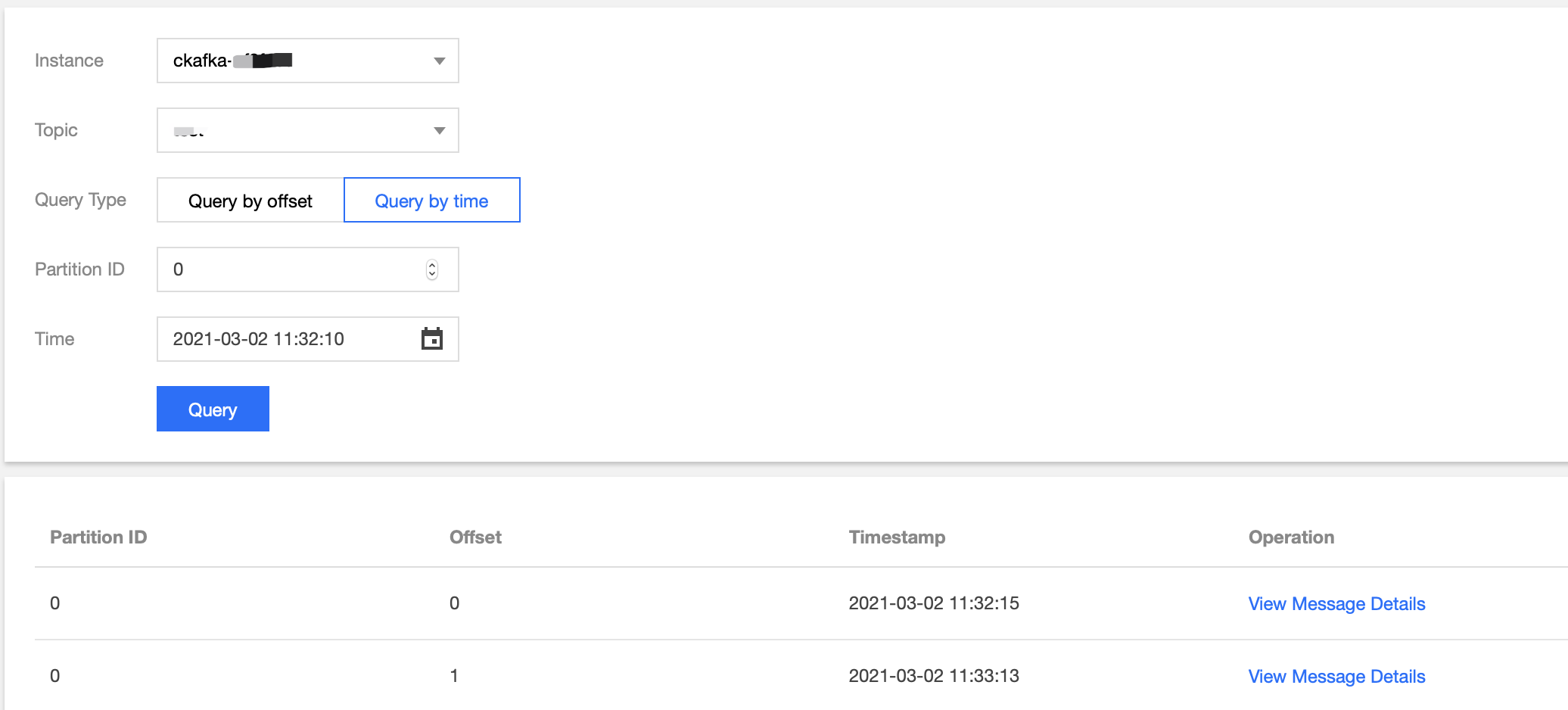
3. The Kafka consumer consumes messages.
package schemaTest;import java.util.Collections;import java.util.Properties;import org.apache.avro.generic.GenericRecord;import org.apache.kafka.clients.consumer.ConsumerRecord;import org.apache.kafka.clients.consumer.ConsumerRecords;import org.apache.kafka.clients.consumer.KafkaConsumer;public class SchemaProduce {public static void main(String[] args) throws Exception {Properties props = new Properties();props.put("bootstrap.servers", "xx.xx.xx.xx:xxxx"); // Access address of the CKafka instanceprops.put("group.id", "schema");props.put("key.deserializer", "org.apache.kafka.common.serialization.StringDeserializer");// Use the Confluent `KafkaAvroDeserializer`props.put("value.deserializer", "io.confluent.kafka.serializers.KafkaAvroDeserializer");// Add the schema service address to obtain the schemaprops.put("schema.registry.url", "http://127.0.0.1:8081");KafkaConsumer<String, GenericRecord> consumer = new KafkaConsumer<>(props);consumer.subscribe(Collections.singletonList("test"));try {while (true) {ConsumerRecords<String, GenericRecord> records = consumer.poll(10);for (ConsumerRecord<String, GenericRecord> record : records) {GenericRecord user = record.value();System.out.println("value = [user.id = " + user.get("id") + ", " + "user.name = "+ user.get("name") + ", " + "user.age = " + user.get("age") + "], "+ "partition = " + record.partition() + ", " + "offset = " + record.offset());}}} finally {consumer.close();}}}
On the Consumer Group tab page in the CKafka console, select the consumer group named
schema, enter the topic name, and click View Consumer Details to view the consumption details.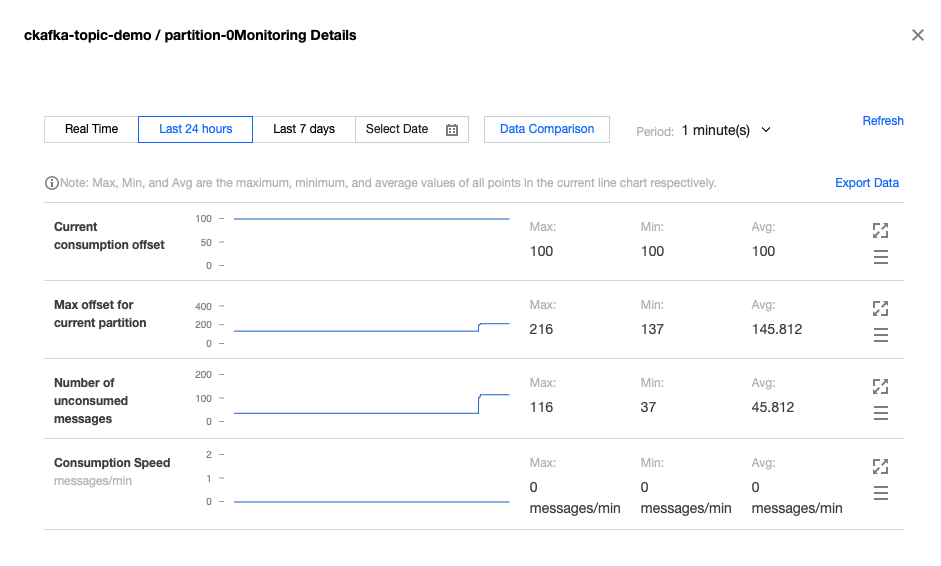
Start the consumer for consumption. Below is a screenshot of the consumption log:
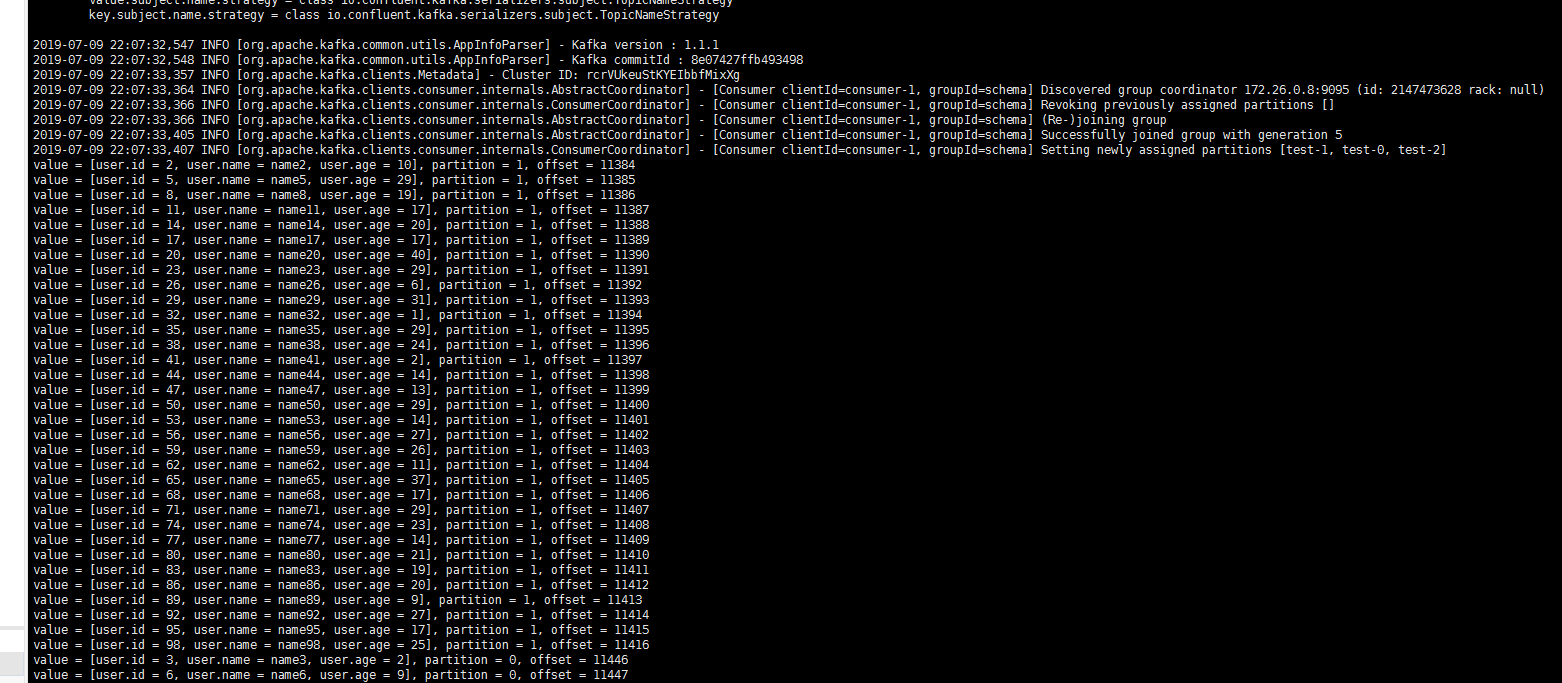
Was this page helpful?
You can also Contact Sales or Submit a Ticket for help.
Yes
No

